

If you want to describe a design project manager’s day-to-day in under 30 seconds, just watch that episode of Friends where Ross moves his new couch upstairs. You know the one: “Pivot! Pivot! Pivooooooooot!”
That’s a bit dramatic. But effective design project management does demand a high level of flexibility—in addition to a detailed request process, clear timelines, and open collaboration from start to finish. That’s because a proper project plan is often the deciding factor in whether a design project succeeds or fails. 😯
But creating your own plan of attack is no walk in the park—design project management is one of the trickiest to nail down, requiring a near-constant stream of cross-functional collaboration between clients, other departments, team members, or all of the above.
Plus, your design requests will rarely be within the same project scope. One day you might be creating a logo and the next you’re redesigning an entire website! It dips its toes into almost every aspect of a business, and we’re here to help you make sense of it all. 🤓
Whether you’re streamlining your current project management process or starting from scratch—this guide is for you. We’ve broken down the essential elements of design project management and summed up the top 10 tips to help design team leads succeed.

What is Design Project Management?
Design project management is the process of managing design projects, creating and delegating tasks, overseeing resources, and following a project through to its completion.
Whether it’s another member of your organization or a client, design project management starts with a request—kind of like a mini creative commission from other departments or businesses.
From there the request is often plugged into a design brief to guide the projects’ next steps, which is where creative project management comes into play.
The purpose isn’t just to solidify graphic design workflows or keep the team on track—the main goal of proper design project management is to bridge the communication gap between the design team and the requestor, whether that be a client or an internal stakeholder.
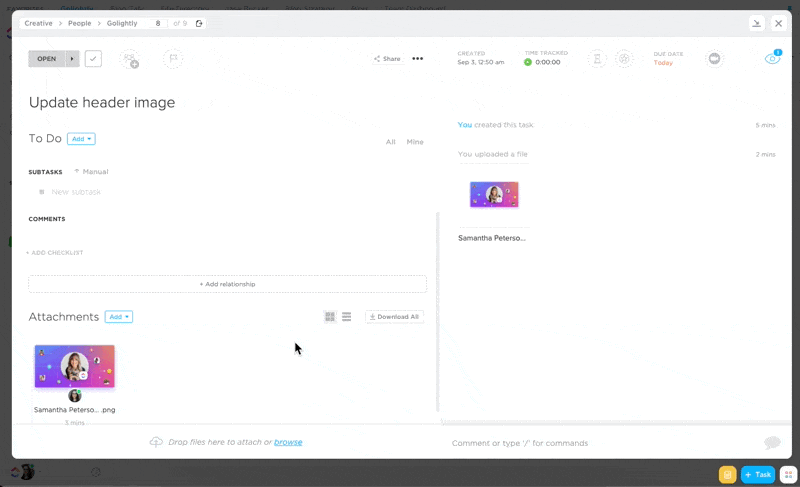
Plus, many design requests require more than one deliverable per project, leading to multiple rounds of feedback and ongoing teamwork to deliver the assets as the requestor expected. A good example of this is an advertising or marketing campaign made up of multiple design assets from creative teams who’re each responsible for a different deliverable.
This requires oversight by the design project manager of multiple timelines, workflows, and approvals to ensure the overall project is completed without unforeseen delays.
Kind of sounds like too many cooks in the kitchen, huh? That’s why the right design project management process is such an important tool!
Why is Design Project Management Important?
To say the least, design project management can be tricky. Things can get spicy fast because each request is so unique. Many project management processes typically follow a similar structure day in and day out—barring a few minor adjustments.
But in the creative world, you’ll likely juggle a handful of smaller design projects per a single request or regularly pivot your approach to accommodate clients across industries.

In this case, it’s almost better to think of your design project management plan as the bumpers on a bowling lane—it keeps the entire team on the right course while leaving tons of room for exploration along the way. 🎳
Having a design process in place gives your design team a sense of direction, even when the request is a bit vague. But it’s not just for the team’s benefit!
The proper project management process gives your client piece of mind by laying the foundation for an open and honest working relationship. It will them think critically about what they’re requesting, how to deliver constructive feedback, and communicating concepts they’ve already envisioned for the project.
This helps design leads get everything they need from the client early on so there are no surprises or disappointments along the way.
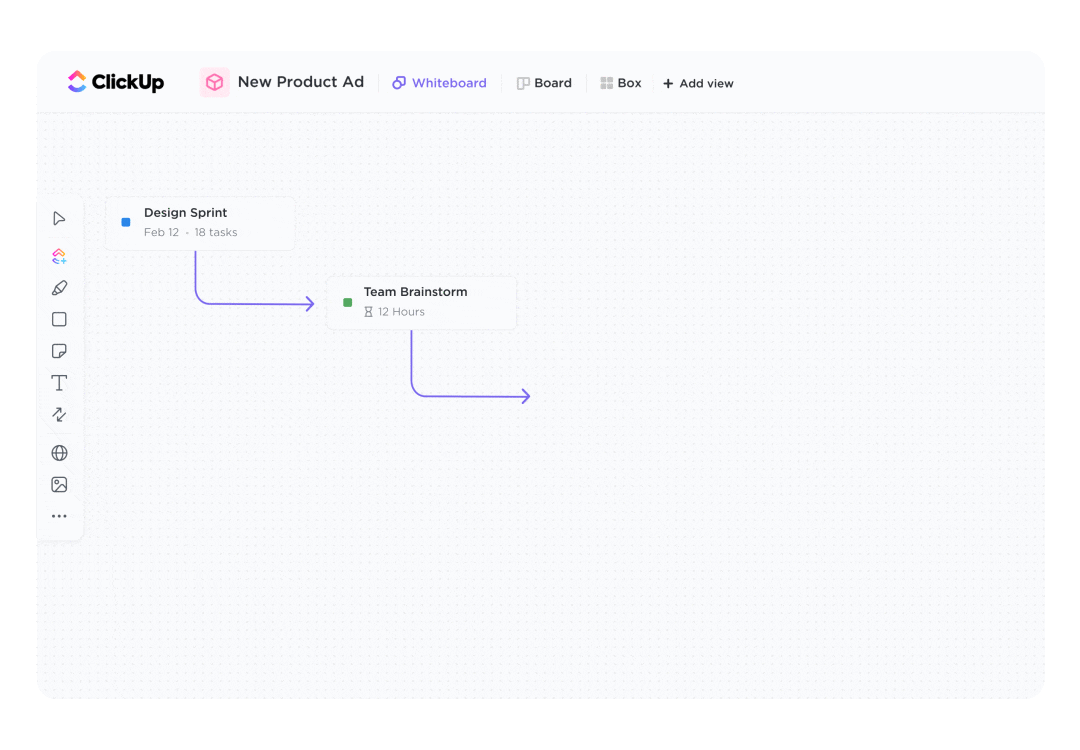
Project Management is the glue to the design project process
Your project lead is always walking a fine line to keep the design team and client happy. It’s all about making sure both sides are on the same page and feel that they can speak openly. You’re all working toward the same goal after all!
Bear in mind, outlining your ideal process is only half the battle. Without the right design project management software, you won’t reap the same benefits or have the ability to follow through as effectively. Project management tools are designed to streamline your processes and take them further with features to:
- Manage your team’s workload and ensure tasks are distributed evenly
- Track progress at a macro and micro level for team and stakeholder benefit
- Brainstorm and collaborate on design concepts
- Visualize and present work easily during meetings
- Automate routine tasks
And more!
Each design project management software has its own special niche—whether it specializes in specific project management methodologies, as a web design tool, supports different ideation techniques, offers a wide range of workflow templates, and so on—so you’ll definitely find one that serves your team best if you don’t already have one in your tech stack.
As you cruise through this guide, take a mental note of the key features mentioned here that would go a long way with your team’s specific needs and use case.
Design Project Management Methodologies
No two projects are alike, so there’s no one-size fits all approach to design project management. Understanding the four main project management methodologies will help you lay a better foundation for your team or clients when starting from scratch.
Waterfall Methodology
The waterfall methodology follows a linear process with distinct phases. It works best for projects with defined requirements and expectations from the start where you’re working within a set timeline.
Agile Methodology
The agile methodology focuses on iterative cycles—breaking down project components into smaller tasks that get completed in manageable chunks of time, typically 4-6 weeks. This method promotes collaboration between all stakeholders and is best for when the scope of a project may change over time.
Kanban Methodology
Kanban methodology is based on visualizing your workflow—limiting the number of tasks you work on in each phase to ensure you’re not taking on more than you can handle. This style works well with teams that rely on tasks or design files passing through multiple hands before hitting completion.
Scrum Methodology
Scrum methodology is a combination of the waterfall and agile approaches, perfect for teams with complex projects that require shorter check-ins to identify priorities in between deadlines. It also provides more structure than traditional agile methods while keeping the team flexible enough to handle changes.
Design Project Management Workflow Phases
As unique as every design project may be, the best way to get after them is by breaking them down into the key phases of project management—from brainstorming through project execution. We’ll show you. 🤓
Phase 1: Brainstorming
Your design project usually starts with a request—not to be confused with a roadmap! Your request just covers the basics of a project, so it’s less of a North Star and more of a springboard for your project management process. It’s what sets the groundwork for the design brief, and where the team’s creativity stems from.
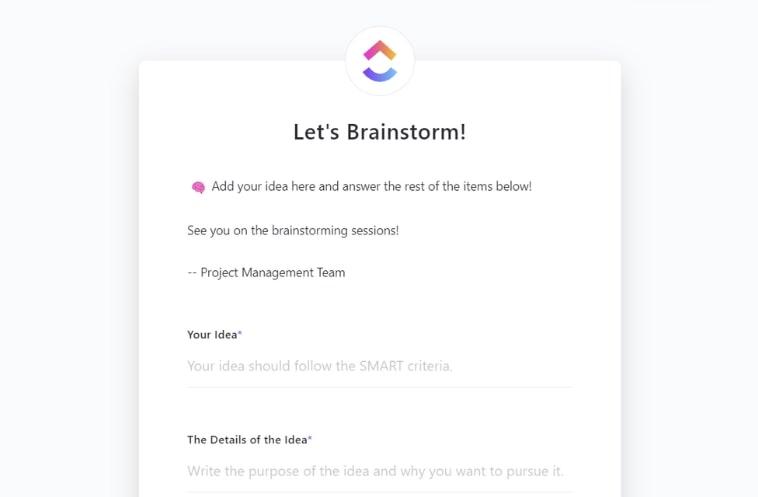
Creative briefs dig into the details of the request, outlining the initial project requirements, objectives, and potential obstacles. It should center around the who, what, where, why, why, and how of your project with a focus on the request and its overall goal.
With your design brief ready, the team can begin brainstorming concepts, drawing mock-ups, and collaborating on ways to fulfill the request. This is best done in a team brainstorming session using proven techniques to inspire creativity within the structure laid out in the brief.
Your creative project management tool will already come in handy here—especially visual tools like digital whiteboard software for creating wireframes, sketching out new concepts, and collaborating on a mood board alongside the team.

PRO TIP
Keep your ideas together and act on them faster when you brainstorm on a ClickUp digital whiteboard! Whiteboards in ClickUp are as collaborative as they are creative, with live cursors to sketch, edit, and present concepts to the team without overlap, they’re the ideal resource for capturing your ideas in an instant. Plus, access hundreds of whiteboard-specific templates for everything from vision boards to action plans to align the team on immediate goals, expectations, and more.
Once you’ve collected your top ideas, it may be time to share them with the client. If you’re using a collaborative whiteboard tool, you can simply present your canvas during the initial meeting to convey your designs properly and most effectively.
Your first meeting is crucial. It’s how project managers can set the expectation for ongoing communication when it comes to the tone, frequency, and channels between the team and client.
It’s also your client’s first opportunity to provide feedback and the team’s first opportunity to apply it—two factors that will play a critical role in your working relationship going forward. The client may already have a vision in mind for the end product.
Now, it’s up to the design leads to use the tools in front of them (i.e. the request, brief, and initial ideas) to ask pinpoint that concept and bring it to life.

Plus, it’s critical that the amount of work required to complete the request aligns with your client’s budget and expectations. This may require some reworking to make both parties happy.
However, setting clear professional boundaries early on will ensure members and clients remain on the same page about what can be completed with the resources at hand. And when your team and stakeholders are in agreement, it’s time to make a project plan!
Phase 2: Project planning and prep
A thorough planning stage sets your team up for overall project success. This is where you can assess your design concept for potential bottlenecks or setbacks, and properly prepare before you proceed.
This information is essential to construct your design project roadmap and eventual task list! And we’re talking about every task involved in the project, not just the ones centered around design alone. A detailed master list of your most important tasks will reveal additional information like task dependencies and will inform your future deadlines.
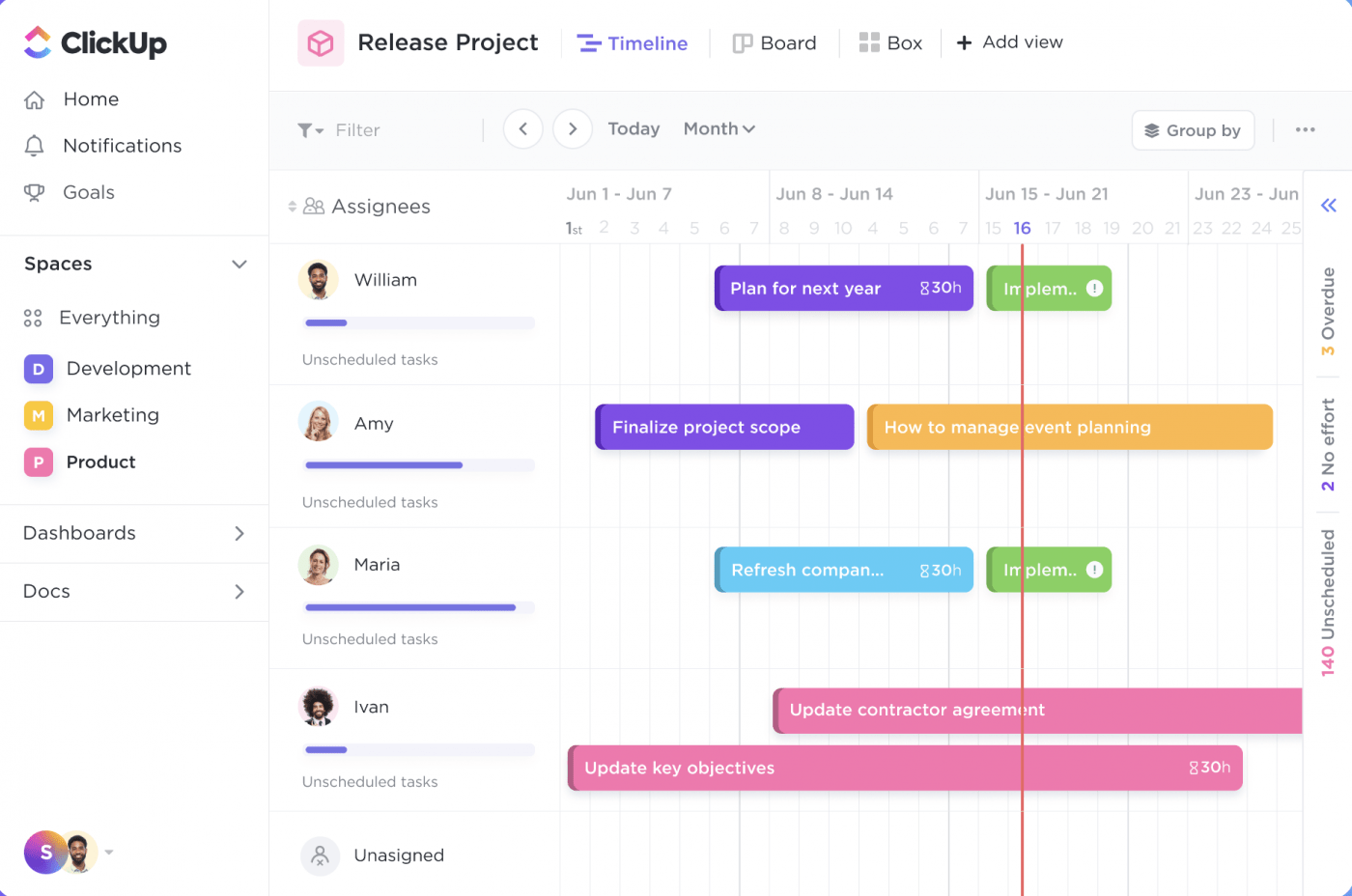
From there, you can begin scheduling any routine meetings, evaluating your resources, and setting a rough project timeline. At this point, your roadmap is already taking shape and soon you’ll be ready to take your project off the whiteboard!
With your high-level project plan, you can hone in on the details to identify your project milestones, and major due dates, and start assigning tasks to build your workflows! Once your tasks are assigned, milestones are set, and deadlines are created, you’ll be ready to move to the next phase.
PRO TIP
If you’re using Whiteboards in ClickUp, you can simply convert shapes from your board into actionable tasks and start acting on your workflow in seconds. Features like multiple assignees, watchers, assigned comments, and custom task statuses will bring more visibility into your task progress from the start and keep members in the loop as the project progresses.
Phase 3: Set your plan in motion
Time for the exciting part—you’re ready to execute! At this point, you’ll be itching to just get started. And proper planning makes that significantly easier.
Your roadmap is essentially the blueprint for the project, but as the team acts on it, project views like Gantt charts, Kanban boards, and calendars will help managers oversee timelines in real-time and from any level. They can also help you anticipate significant project events like milestones and upcoming stakeholder meetings!
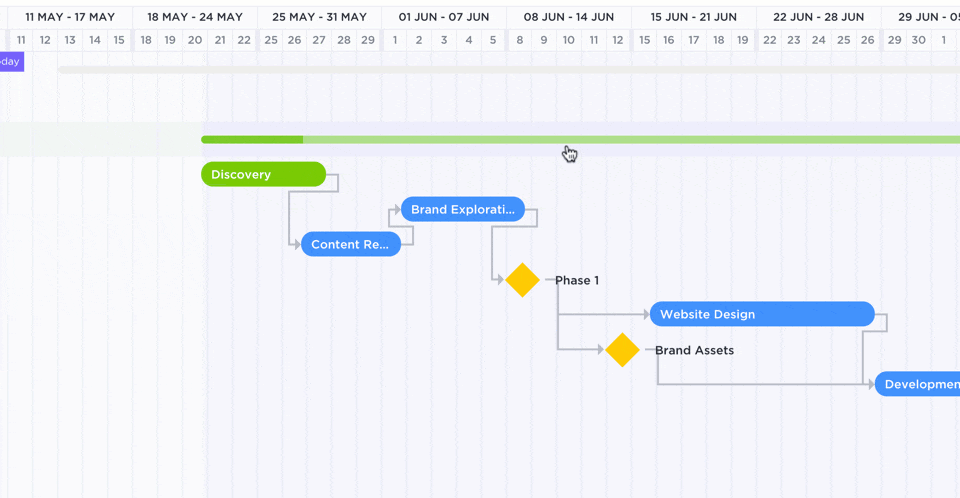
Make sure you’re consistently checking in with your clients and holding enough meetings with the team and external stakeholders to keep everyone informed on any major changes. Regular check-ins with the team shouldn’t take away important design time, but a weekly 10-minute block to touch base will give you peace of mind when reporting back to stakeholders.
Phase 4: Staying on track
As your project progresses, you’ll have at least one major round of feedback from your client. Ideally, your check-ins along the way have ensured there’re no big surprises here, and the edits are minor! But it’s still crucial that you allow enough time for proper revisions as a precaution.
While the idea of feedback and multiple iterations can feel like a bit of a gray area in your schedule, there are tons of ways to stay on track and ahead of the curve as your final deadline approaches like:
- Task automations to eliminate busy work from your team’s plate
- Keep a shared design folder handy to reference past work, hold current designs, and in general, keep your important work together
- Creating a standardized method for naming and exporting your work so you’ll never lose time searching for assets
PRO TIP
ClickUp Dashboards give managers a customizable bird’s eye view of their project health to ensure peak performance. You can track your progress toward completion by the number of Milestones reached, calculate time spent on tasks, review your team’s workload, and more! So you’ll never feel surprised by your project schedule.
Phase 5: Project closing and reflecting
The project may be coming to a close, but it’s far from over! Particularly when it comes to client relationships.
In this stage, you are turning over the approved deliverables to your client or stakeholders for the last time and ensuring you met their expectations from top to bottom. As a project manager, this is also the time to double-check that every task is marked as complete and that the internal copies or your assets are properly named and categorized.
The final stage of your project management process can be used to touch back with your client and reflect on the experience overall. Use this as an opportunity to learn from failures.
Was there any part of your design process that didn’t go as planned?
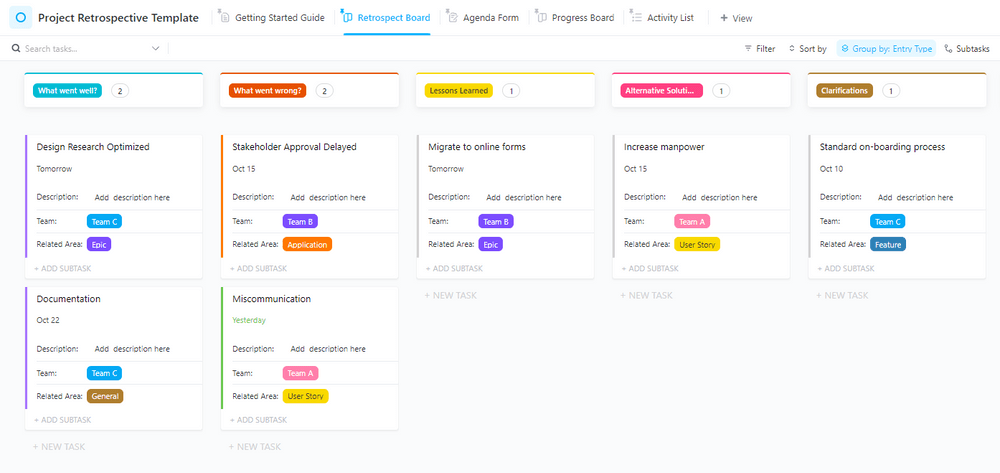
Take the time to consider what worked well and, simply put, what just didn’t. Make the process even easier for your project team with the ClickUp Project Retrospective Template. This will help you avoid repeating the same mistakes and ultimately help you become a better project manager.
Plus, your client will appreciate it—and likely return to your team for other design projects in the future!
10 Tips for Design Project Managers
So, we’ve outlined the elements driving each phase of project management—but the best-kept secrets of design project management lie in the details!
Before your next kick-off meeting, take a look through these tried and true tricks of the trade to make your efforts even more impactful to the team.
1. Keep iterating your design request forms
As you take on more design projects, think of ways to probe the right information out of your clients right out of the gate. Cover the basics but also get specific, ask questions, and use previous client feedback in addition to your own experience to perfect your intake process.

Form view in ClickUp will make this simple, easy, and presentation-ready with a simple URL to share with clients. Once they’re finished, your Form will automatically turn into an actionable task in ClickUp so the team wastes no time reviewing, brainstorming, and creating your project strategy.
2. Get the whole team on board
Before you consider bringing in the client, make sure your entire team is connected and in agreement with the final assets. Have the team review the final project internally to voice any last-minute concerns and iron out the little details that make all the difference for your client.
3. Define clear project goals
No matter the type of project goals or expectations, in the very first meeting you have to avoid misunderstandings and awkward client conversations. The best way to do this is by coming prepared with meeting notes or detailed project goals to keep the conversation on track.
4. Lean on your collaboration tools
Silos are the death of any great design project. Encourage your team to work together and communicate often. But we get it—the problem usually comes back to things getting lost in email.
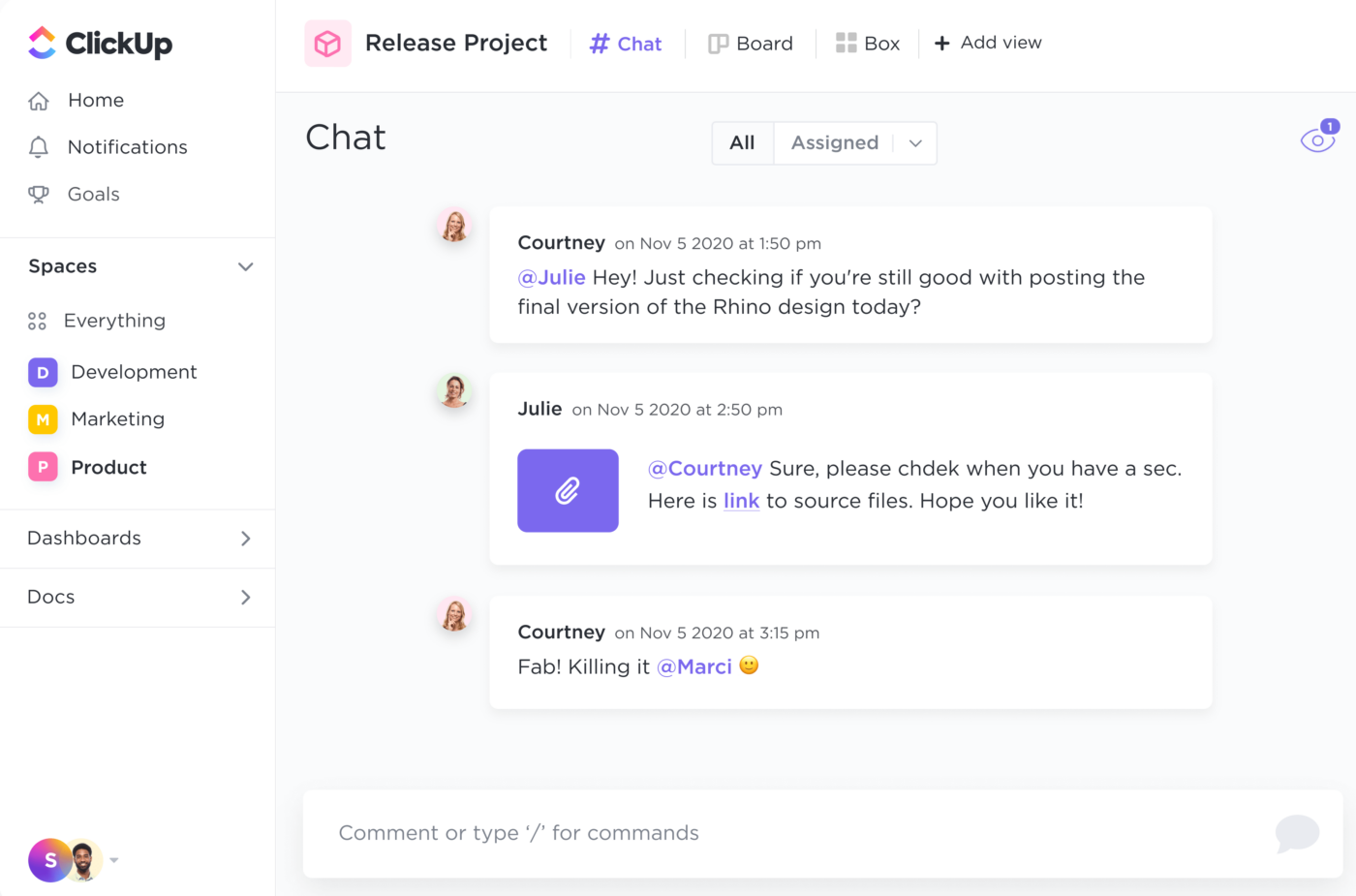
It doesn’t have to be that way. Tools like Chat view in ClickUp will centralize all of your project conversations and include every member of the team without the pressure of external stakeholders watching your every move.
5. Avoid over-communication
There’s a fine line, and you want to toe it! Overly communicative managers give off the “micromanagement” vibe, really fast—even if they’re well-intentioned. Custom task statuses give managers visibility to individual task progress and eliminate the need for daily check-ins.
6. Custom Fields are your friend
Bring more information into every glance to avoid digging through a pool of tasks to find the update you’re looking for. And if you’re using Custom Fields in ClickUp, you can even track billable time, notes, iterations, and updates without ever leaving your List.

You can even filter and group tasks based on your Custom Fields to comb through tasks in a matter of seconds and work more efficiently across the board.
7. Be flexible
Try to give yourself more time than you think. This buffer time will ease the team’s mind and keep projects on time, even when unexpected challenges arise.
8. Respect your team’s boundaries
Don’t book meetings over your team’s focus time, and don’t give in to all of your client’s last-minute requests for an additional meeting. This will also help your team find a healthy work-life balance and lead to a more positive attitude toward the project.
9. Prioritize creativity and structure
Design project management is a constant balancing act! Giving your designers clear parameters to work within will ensure they’re channeling their creativity in the most productive way.
10. Get feedback from the team
Like a team retrospective, ask your designers what went well and what caused problems so you can improve their experience at work. Get to know their skillset, workstyles, preferred communication channels, and strengths.
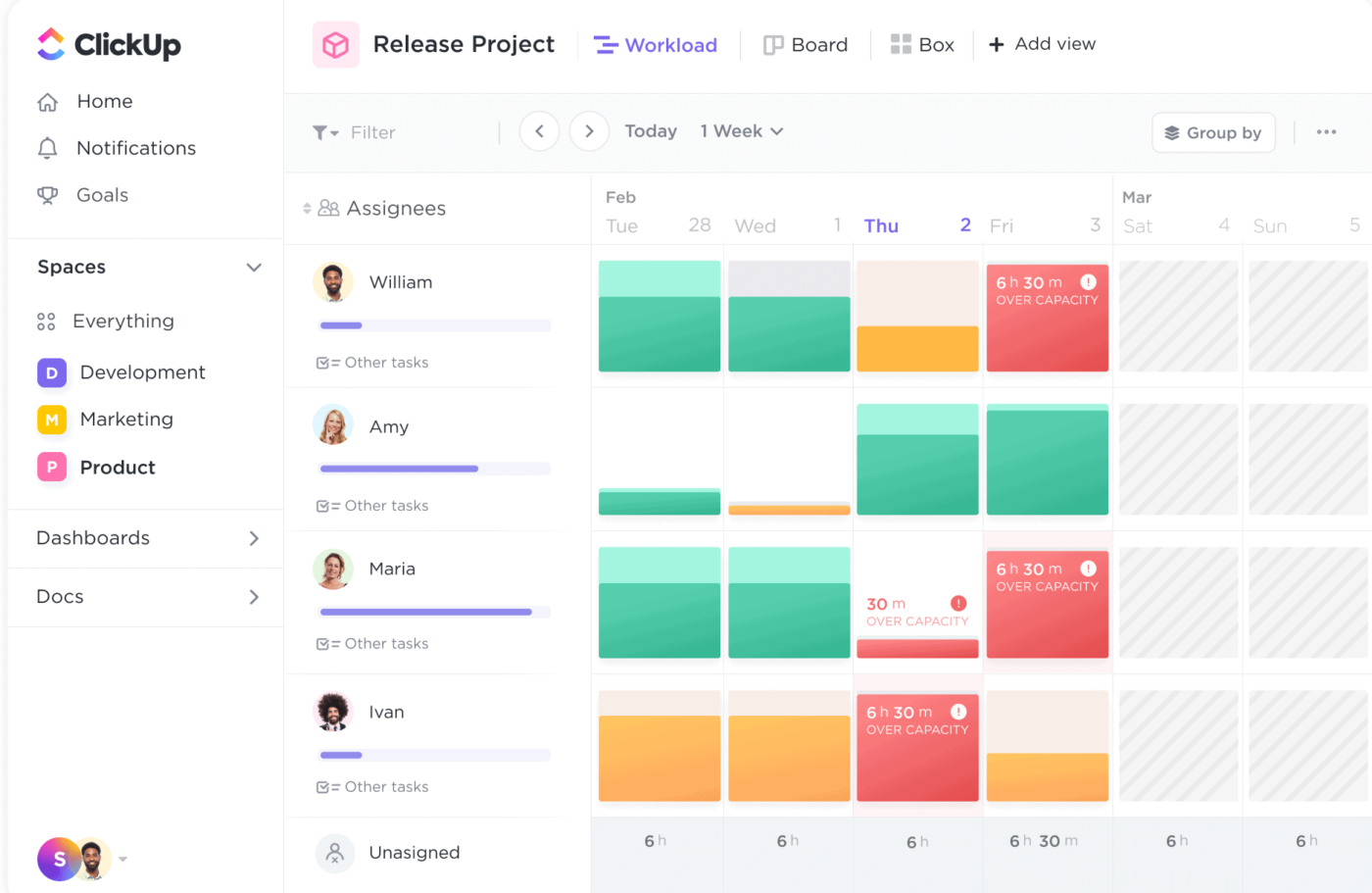
Don’t be afraid to make another survey—it might sound a little cheesy but your team will really appreciate it. The Workload view in ClickUp will give you an idea of who is overworked, who has additional bandwidth, and where your team is in their workload overall!
Design Project Management Software
The best way to help design leads succeed in every project? Start with the right creative project management tools!

ClickUp is the only project management tool powerful enough to bring all of your work together in one collaborative and dynamic platform. With thousands of customizable templates, hundreds of project management software features, and over 1,000 integrations, it’s ideal for any design team at any stage in their project management process.
Make the most of the pro tips noted throughout this article and streamline your project management process when you sign up for ClickUp’s Free Forever Plan—or upgrade your feature list for as little as $7!



